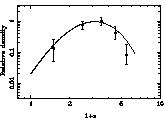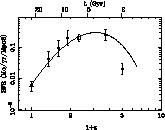


How are formed and grow the massive black holes in the center of galaxies? Can we explain the observed peak in quasar activity at z = 2 and the decline since then (see fig 23)? Why is this curve so parallel to the star formation history? If galaxies are themselves formed through interactions and mergers, what is the fate of the black holes in the merger, and are binary black holes observable ?

| 
|
Figure 23. left Space density as a function of redshift, normalised to z = 2 - 3, for the Parkes flat-spectrum radio-loud quasars with P11 > 7.2 1026 W Hz-1 sr-1. The optically-selected quasars follow the same curve (from Shaver et al. 1996). right Cosmic history of star formation, for comparison. The various data points, coming from different surveys, give the universal metal ejection rate, or the star formation rate SFR (left-scale), as a function of redshift z. | |